Gastric and Duodenal Antiulcer Activity of Alkaloids: A Review
Abstract
:Introduction
Alkaloids studied in models that investigate the antiulcer activity
| Substance | Experimental models/dose – Route of administration | Organism tested | Effect |
|---|---|---|---|
| Imidazole alkaloids | |||
| Allantoin | Phenylbutazone induced ulcer/6 g/kg – gastric intubation | Rat | Active [61] |
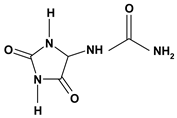 | */oral | Human adult | * [62] |
| Histamine, para-coumaroyl | */ 100 mg/kg – intragastric | Mouse | Equivocal [63] |
 | 50% ethanol induced gastric ulcer/2.5; 10 and 20 mg/kg – oral and intraperitoneal | Mouse | Active [59] |
4-Methoxycantin-6-one 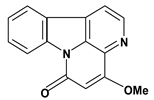 | 50% ethanol induced gastric ulcer/ 10 and 20 mg/kg – oral and intraperitoneal | Mouse | Active [59] |
Hirsuteine  | */60 mg/kg – intraperitoneal | Mouse | Active [56] |
Hirsutine  | */60 mg/kg – intraperitoneal | Mouse | Active [56] |
LSD-25 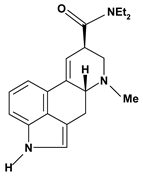 | 5-HT induced gastric ulcers/30mg/kg – intramuscular | Guinea pig | Active [64] |
| Melatonin | */intragastric | Rat | Active [55] |
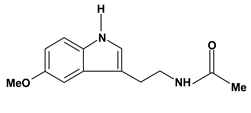 | Ischemia-reperfusion induced ulcer/intragastric | Rat | Active [55] |
| Nigakinone | */* | Rat | Active [57] |
 | Pylorus-ligated induced ulcer/31.3 mg/kg - * | Rat | Active [57] |
Nigakinone, methyl 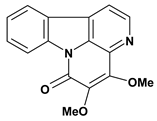 | Pylorus-ligated induced ulcer/62.5 mg/kg - * | Rat | Active [58] |
| Reserpine | Stress induced ulcer/2.5 mg/kg –subcutaneous | Mouse | Inactive [46] |
 | |||
Rhynchophylline 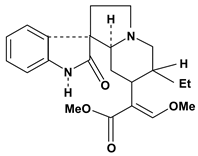 | */60 mg/kg – intraperitoneal | Mouse | Active [56] |
Rhynchophylline, iso 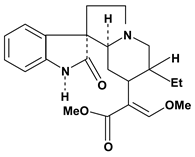 | */60 mg/kg – intraperitoneal | Mouse | Inactive [56] |
Tabersonine  | */50 mg/kg – intragastric | Rat | Active [34] |
Vinpocetine 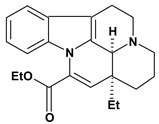 | */10 mg/kg – oral | Human adult | Active [65] |
Yohimbine, beta 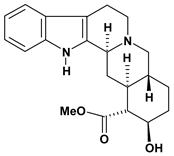 | */20 mg/kg – intraperitoneal | Mouse | Active [56] |
| Isoquinoline alkaloids | |||
| Berberine | Ethanol induced gastric ulcer/25 mg/kg – intragastric | Rat | Inactive [30] |
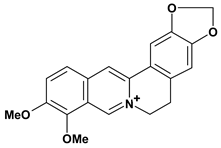 | */15 mg/kg – gastric intubation | Rat | Weak activity [31] |
| Pylorus-ligated induced ulcer/10 mg/kg – oral | Rat | Inactive [32] | |
Berberine, oxy  | Ethanol induced gastric ulcer/50 mg/day - intragastric | Rat | Inactive [30] |
Cathinone  | */intragastric | Rat | Active [66] |
| Cathinone, (-) | Aspirin induced gasric ulcer/10 mg/kg - intragastric | Rat | Active [28] |
| Indomethacin induced gastric ulcer/10 mg/kg - intragastric | Rat | Active [28] | |
| Phenylbutazone induced gastric ulcer/10 mg/kg - intragastric | Rat | Active [28] | |
| Cathinone, (+) | Aspirin induced gasric ulcer/10 mg/kg - intragastric | Rat | Active [28] |
| Indomethacin induced gastric ulcer/10 mg/kg - intragastric | Rat | Active [28] | |
| Phenylbutazone induced gastric ulcer/10 mg/kg - intragastric | Rat | Active [28] | |
| Coptisine | Ethanol induced gastric ulcer/0.1 mg/kg - intragastric | Rat | Active [30] |
 | 80% ethanol induced ulcer/0.1 mg/kg - intragastric | Rat | Active [35] |
| 80% ethanol induced ulcer/0.1 mg/kg - intragastric | Rat | Active [36] | |
| Coptisine, 8-oxo | Ethanol induced gastric ulcer/0.1 mg/kg - intragastric | Rat | Active [30] |
 | 80% ethanol induced ulcers/0.1 mg/kg - intragastric | Rat | Active [35] |
Corydaline 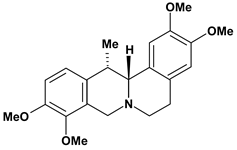 | */15 mg/kg - oral | Human adult | Active [67] |
| Corydaline, dehydro | */40 mg/kg - oral | Mouse | Active [68] |
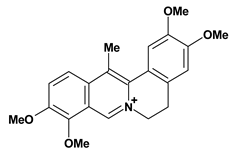 | */* | Bullfrog | Active [68] |
| Pylorus-ligated induced gastric ulcer/oral | Rat | Active [69] | |
| Stress induced gastric ulcer/oral | Rat | Active [69] | |
| Pylorus-ligated induced gastric ulcer/subcutaneous | Rat | Active [69] | |
| Stress induced gastric ulcer/subcutaneous | Rat | Active [69] | |
| Histamine induced ulcers of duodenum/oral | Guinea pig | Active [69] | |
| Histamine induced ulcers of duodenum/subcutaneous | Guinea pig | Inactive [69] | |
| Reserpine induced gastric ulcer/oral | Rat | Active [69] | |
| Reserpine induced gastric ulcer/subcutaneous | Rat | Inactive [69] | |
Corydamine 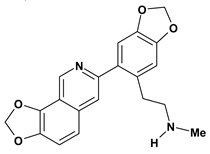 | */* | * | Active [70] |
Corydamine, tetrahydro  | */* | * | Active [71] |
| Ephedrine, nor- n-formyl (-) | Aspirin induced ulcers/5 mg/kg - intragastric | Rat | Active [28] |
 | Indomethacin induced ulcers/10 mg/kg - intragastric | Rat | Active [28] |
Ephedrine, nor-
n-formyl (+)  | Aspirin induced ulcers/5 mg/kg - intragastric | Rat | Active [28] |
| Glaziovine | Histamine induced ulcers/5 mg/kg - intraperitoneal | Guinea pig | Active [72] |
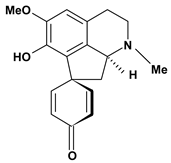 | Reserpine induced ulcers/5 mg/kg - intraperitoneal | Rat | Active [72] |
| Serotonin induced ulcers/5 mg/kg - intraperitoneal | Rat | Active [72] | |
| Restraint stress induced ulcers/5 mg/kg - intraperitoneal | Rat | Active [72] | |
| Pylorus-ligated induced ulcers/5 mg/kg - intraperitoneal | Rat | Active [72] | |
| */10 mg/person - oral | Human adult | Active [73] | |
Morphine 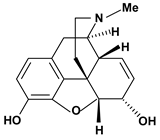 | Reserpine induced ulcers/10 mg/kg - oral | Rat | Active [29] |
| Palmatine, 7-8-dihydro: 8-hydroxy | Ethanol induced gastric ulcers/50 mg/kg - intragastric | Rat | Active [33] |
 | Pylorus-ligated induced ulcers/50 mg/kg - intragastric | Rat | Active [33] |
| Acetic acid induced ulcers/80 mg/kg - intragastric | Rat | Active [33] | |
| */100 mg/kg - intragastric | Rat | Active [34] | |
| Non- nitrogen heterocycle alkaloid | |||
| Chlorophyll | Pylorus-ligated induced ulcers/1 g/kg - intravenous | Rat | Active [74] |
 | |||
| Phenylalkylamide alkaloid | |||
| Capsaicin | Ethanol induced gastric ulcer/0.3 nanomol/kg - intragastric | Rat | Active [52] |
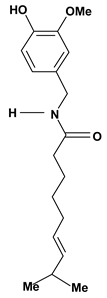 | 80% ethanol induced ulcer/2 mg/kg - intragastric | Rat | Active [75] |
| 80% ethanol induced ulcer/2 mg/kg - subcutaneous | Rat | Active [75] | |
| Pylorus-ligated induced ulcer/1 μg/kg - intragastric | Rat | Active [76] | |
| Aspirin induced ulcer/0.6 μg/kg - intragastric | Rat | Active [77] | |
| Ethanol induced ulcer/0.105 μg/kg - intragastric | Rat | Active [77] | |
| HCl induced ulcer/0.1 μg/kg - intragastric | Rat | Active [77] | |
| Acetic acid induced ulcer/10 mg/kg - intragastric | Rat | Active [78] | |
| */0.5 mg/kg - intragastric | Rat | Active [53] | |
| Piperidine alkaloid | |||
| Piperine | Aspirin induced ulcer/1,5 mg/kg - intravenous | Rabbit | Active [50] |
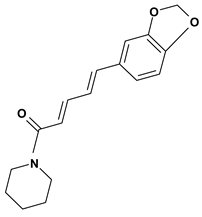 | Restraint stress induced ulcer/25 mg/kg - intragastric | Rat | Active [51] |
| Indomethacin induced ulcer/25 mg/kg - intragastric | Rat | Active [51] | |
| HCl/ethanol induced gastric ulcer/25 mg/kg - intragastric | Rat | Active [51] | |
| Pylorus-ligated induced ulcer/25 mg/kg - intragastric | Rat | Active [51] | |
| Restraint stress induced ulcer/25 mg/kg - intragastric | Mouse | Active [51] | |
| Indomethacin induced ulcer/25 mg/kg - intragastric | Mouse | Active [51] | |
| HCl/ethanol induced gastric ulcer/25 mg/kg - intragastric | Mouse | Active [51] | |
| Pylorus-ligated induced ulcer/25 mg/kg – intragastric | Mouse | Active [51] | |
| Pyrazine alkaloid | |||
| Ligustrazine | Water-immersion stress induced ulcer/intragastric | Rat | Active [79] |
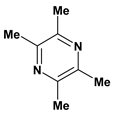 | Restraint stress induced ulcer/intragastric | Rat | Active [79] |
| Pyridine alkaloids | |||
| Gentianine | Pylorus-ligated induced ulcers/100 mg/kg - oral | Rat | Weak activity [80] |
 | Water-immersion stress-induced ulcers/100 mg/kg - oral | Rat | Active [80] |
Mallorepine  | Stress induced gastric ulcer/300 mg/kg - subcutaneous | Mouse | Inactive [81] |
Nicotine  | Aspirin induced ulcer/1mg/animal - intragastric | Rat | Active [44] |
| Pyrrolidine alkaloid | |||
Cuscohygrine  | */* | Rat | Active [82] |
| Pyrrolizidine alkaloids | |||
| Interregimine | Hypothermic restraint stress induced gastric ulcer/12.5 mg/kg of crude alkaloid extract - oral | Mouse | Active [60] |
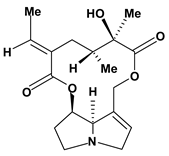 | Ethanol induced gastric ulcer/12.5 mg/kg of crude alkaloid extract - oral | Rat | Active [60] |
| Cysteamine induced duodenal ulcer/12.5 mg/kg of crude alkaloid extract - oral | Rat | Active [60] | |
| Indomethacin induced gastric ulcer/12.5 mg/kg of crude alkaloid extract - oral | Mouse | Active [60] | |
Retrorsine 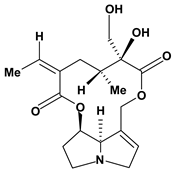 | Hypothermic restraint stress induced gastric ulcer/12.5 mg/kg of crude alkaloid extract - oral | Mouse | Active [60] |
| Ethanol induced gastric ulcer/12.5 mg/kg of crude alkaloid extract - oral | Rat | Active [60] | |
| Cysteamine induced duodenal ulcer/12.5 mg/kg of crude alkaloid extract - oral | Rat | Active [60] | |
| Indomethacin induced gastric ulcer/12.5 mg/kg of crude alkaloid extract – oral | Mouse | Active [60] | |
Senecionine 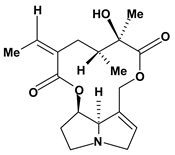 | Hypothermic restraint stress induced gastric ulcer/12.5 mg/kg of crude alkaloid extract – oral | Mouse | Active [60] |
| Ethanol induced gastric ulcer/12.5 mg/kg of crude alkaloid extract - oral | Rat | Active [60] | |
| Cysteamine induced duodenal ulcer/12.5 mg/kg of crude alkaloid extract - oral | Rat | Active [60] | |
| Indomethacin induced gastric ulcer/12.5 mg/kg of crude alkaloid extract – oral | Mouse | Active [60] | |
Seneciphylline 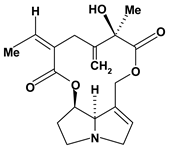 | Hypothermic restraint stress induced gastric ulcer/12.5 mg/kg of crude alkaloid extract - oral | Mouse | Active [60] |
| Ethanol induced gastric ulcer/12.5 mg/kg of crude alkaloid extract - oral | Rat | Active [60] | |
| Cysteamine induced duodenal ulcer/12.5 mg/kg of crude alkaloid extract - oral | Rat | Active [60] | |
| Indomethacin induced gastric ulcer/12.5 mg/kg of crude alkaloid extract - oral | Mouse | Active [60] | |
Usaramine 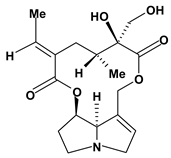 | Hypothermic restraint stress induced gastric ulcer/12.5 mg/kg of crude alkaloid extract - oral | Mouse | Active [60] |
| Ethanol induced gastric ulcer/12.5 mg/kg of crude alkaloid extract - oral | Rat | Active [60] | |
| Cysteamine induced duodenal ulcer/12.5 mg/kg of crude alkaloid extract - oral | Rat | Active [60] | |
| Indomethacin induced gastric ulcer/12.5 mg/kg of crude alkaloid extract - oral | Mouse | Active [60] | |
| Quinolizidine alkaloids | |||
| Matrine | Water-immersion stress induced ulcers/25 mg/kg - gastric intubation | Mouse | Active [45] |
 | Restraint stress induced ulcers/25 mg/kg - gastric intubation | Mouse | Active [45] |
| Water-immersion stress induced ulcers/10 mg/kg - intraperitoneal | Mouse | Weak activity [45] | |
| Restraint stress induced ulcers/10 mg/kg - intraperitoneal | Mouse | Weak activity [45] | |
| Water-immersion stress induced ulcers/10 mg/kg - intravenous | Mouse | Active [45] | |
| Restraint stress induced ulcers/10 mg/kg – intravenous | Mouse | Active [45] | |
| Stress induced ulcer/50 mg/kg - gastric intubation | Mouse | Active [46] | |
| Stress induced ulcer/50 mg/kg -Intraperitoneal | Mouse | Active [46] | |
| Restraint stress induced ulcers/50 mg/kg - gastric intubation | Mouse | Active [47] | |
| Restraint stress induced ulcers/50 mg/kg - intraperitoneal | Mouse | Weak activity [47] | |
| Restraint stress induced ulcers/50 mg/kg – intravenous | Mouse | Active [47] | |
| Pylorus-ligated induced ulcers/50 mg/kg - intraduodenal | Rat | Inactive [45] | |
| Indomethacin induced ulcers/100 mg/kg - gastric intubation | Mouse | Inactive [45] | |
| Reserpine induced ulcers/ 50 mg/kg – gastric intubation | Mouse | Active [45] | |
| Reserpine induced ulcers/25 mg/kg - intravenous | Mouse | Active [45] | |
| Matrine, 13-alpha-hydroxy | Water-immersion stress induced ulcers/* - intragastric | Rat | Active [48] |
 | Indomethacin plus alcohol induced gastric ulcers/ * -intragastric | Rat | Active [48] |
| Matrine, oxy | Pylorus-ligated induced ulcers/* | * | Active [49] |
 | Indomethacin induced ulcers/* | * | Active [49] |
| Restraint stress induced ulcers/ * - intraduodenal | Rat | Active [49] | |
| Water-immersion stress induced ulcers/25mg/kg - gastric intubation | Mouse | Active [45] | |
| Restraint stress induced ulcers/25 mg/kg - gastric intubation | Mouse | Active [45] | |
| Water-immersion stress induced ulcers/10 mg/kg - intraperitoneal | Mouse | Active [45] | |
| Restraint stress induced ulcers/10 mg/kg – intraperitoneal | Mouse | Active [45] | |
| Water-immersion stress induced ulcers/10 mg/kg - intravenous | Mouse | Weak activity [45] | |
| Restraint stress induced ulcers/10 mg/kg - intravenous | Mouse | Weak activity [45] | |
| Stress induced ulcer/50 mg/kg - gastric intubation | Mouse | Active [46] | |
| Stress induced ulcer/50 mg/kg -intraperitoneal | Mouse | Active [46] | |
| Restraint stress induced ulcers/50 mg/kg - gastric intubation | Mouse | Active [47] | |
| Restraint stress induced ulcers/50 mg/kg - intraperitoneal | Mouse | Active [47] | |
| Restraint stress induced ulcers/50 mg/kg - intravenous | Mouse | Weak activity [47] | |
| Indomethacin induced ulcers/100 mg/kg - gastric intubation | Mouse | Active [45] | |
| Reserpine induced ulcers/50 mg/kg - gastric intubation | Mouse | Active [45] | |
| Reserpine induced ulcers/50 mg/kg - intravenous | Mouse | Inactive [45] | |
| Pylorus-ligated induced ulcers/* - gastric intubation | Rat | Active [84] | |
| Steroid alkaloids | |||
| Pachysamine A, epi | Water-immersion stress induced ulcers/50 mg/kg - intraperitoneal | Mouse | Active [54] |
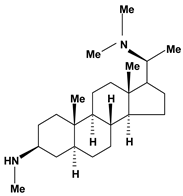 | Restraint stress induced ulcers/50 mg/kg – intraperitoneal | Mouse | Active [54] |
Pachysandrine A 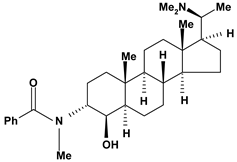 | Water-immersion stress induced ulcers/50 mg/kg - intraperitoneal | Mouse | Active [54] |
| Pachystermine A | Restraint stress induced ulcers/50 mg/kg - intraperitoneal | Mouse | Active [54] |
| Water-immersion stress induced ulcers/50 mg/kg - intraperitoneal | Mouse | Active [54] | |
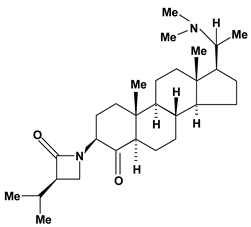 | |||
| Spiropachysine | Water-immersion stress induced ulcers/50 mg/kg - intraperitoneal | Mouse | Active [54] |
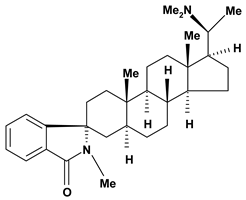 | Restraint stress induced ulcers/50 mg/kg - intraperitoneal | Mouse | Active [54] |
| Tropane alkaloids | |||
| Anisodamine | Water-immersion stress induced ulcers/10 mg/kg – intraperitoneal | Rat | Active [41] |
 | Reserpine induced ulcers/1.5 mg/kg - intraperitoneal | Rat | Active [42] |
| Cold stress induced ulcers/2.5 mg/kg - intraperitoneal | Rat | Active [39] | |
| Indomethacin induced ulcers/0.5 mg/kg - intraperitoneal | Rat | Active [39] | |
| Acetic acid induced ulcers/10 mg/kg - intraperitoneal | Rat | Active [39] | |
| Ethanol induced ulcers/25 mg/kg- intragastric | Rat | Active [43] | |
| Indomethacin induced ulcers/25 mg/kg - intragastric | Rat | Active [43] | |
| Restraint stress induced ulcers/25 mg/kg - intragastric | Rat | Active [43] | |
| Pylorus-ligated induced ulcers/25 mg/kg - intragastric | Rat | Active [43] | |
| Reserpine induced ulcers/1.5 mg/kg - intraperitoneal | Rat | Active [42] | |
| Anisodine | Cold stress induced ulcers/2 mg/kg - intraperitoneal | Rat | Active [39] |
 | Indomethacin induced ulcers/8 mg/kg - intraperitoneal | Rat | Active [39] |
| Acetic acid induced ulcers/32 mg/kg - intraperitoneal | Rat | Active [39] | |
| Atropine | Pylorus-ligated induced ulcers/10 mg/kg - intragastric | Rat | Active [37] |
 | Pylorus-ligated induced ulcers/10 mg/kg - gastric intubation | Rat | Active [38] |
| Aspirin induced ulcers/10 mg/kg - gastric intubation | Rat | Active [38] | |
Cocaine 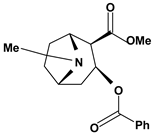 | Reserpine induced ulcers/10 mg/kg - oral | Rat | Active [29] |
| Scopolamine | Cold stress induced ulcers/0.5 mg/kg - intraperitoneal | Rat | Active [39] |
 | Indomethacin induced ulcers/1 mg/kg - intraperitoneal | Rat | Active [39] |
| Acetic acid induced ulcers/8 mg/kg – intraperitoneal | Rat | Active [39] | |
Scopolamine, methyl  | Propionitrile-induced duodenal ulcers/2.5 mg/kg - subcutaneous | Rat | Active [40] |
| Tropine, n-(4’-ethoxy-carbonyl-phenyl-amine-n’-acetyl) | */10 mg/kg - intragastric | Rat | Active [83] |
 | |||
| Tropine, n-(4’-ethoxy-phenyl-amine-n’-acetyl) | */10 mg/kg - intragastric | Rat | Active [83] |
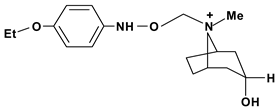 | |||
| Tropine, N-(4’-sulfamoyl-phenyl-amine-N’-acetyl) | */10 mg/kg - intragastric | Rat | Inactive [83] |
 | |||
Conclusions
Acknowledgements
References and Notes
- Yuan, Y.; Padol, I.T.; Hunt, R.H. Peptic ulcer disease today. Nat. Clin. Pract. Gastroenterol. Hepatol. 2006, 3, 80–89. [Google Scholar] [CrossRef]
- Tarnawski, A.S. Cellular and molecular mechanisms of gastrointestinal ulcer healing. Digest. Dis. Sci. 2005, 50, 24–33. [Google Scholar] [CrossRef]
- Wallace, J.L.; Granger, D.N. The cellular and molecular basis of gastric mucosal defense. FASEB J. 1996, 10, 731–740. [Google Scholar]
- Kaunitz, J.D.; Akiba, Y. Gastroduodenal mucosal defense: role of endogenous mediators. Curr. Opin. Gastroenterol. 2004, 20, 526–532. [Google Scholar] [CrossRef]
- Bandyopadhyay, D.; Biswas, K.; Bhattacharyya, M.; Reiter, R.J.; Banerjee, R.K. Gastric toxicity and mucosal ulceration induced by oxygen-derived reactive species: protection by melatonin. Curr. Mol. Med. 2001, 1, 501–513. [Google Scholar] [CrossRef]
- Cechinel Filho, V.; Yunes, R.A. Estratégias para obtenção de compostos farmacologicamente ativos a partir de plantas medicinais: conceitos sobre modificação estrutural para otimização da atividade. Quim. Nova 1998, 21, 99–105. [Google Scholar] [CrossRef]
- Kaplan, M.A.C.; Gottlieb, O.R. Busca racional de princípios ativos em plantas. Interciência 1990, 15, 26–29. [Google Scholar]
- Elisabetsky, E.; Costa-Campos, L. Medicinal plant genetic resources and international cooperation: the Brazilian perspective. J. Ethnopharmacol. 1996, 51, 111–119. [Google Scholar] [CrossRef]
- Secco, R.S. Produtos naturais: alternativa segura? Cienc. Cult. 1990, 42, 807–810. [Google Scholar]
- Ziegler, J.; Facchini, P.J. Alkaloid biosynthesis: metabolism and trafficking. Annu. Rev. Plant Biol. 2008, 59, 735–769. [Google Scholar] [CrossRef]
- Henriques, A.T.; Limberger, R.P.; Kerber, V.A.; Moreno, P.R.H. Farmacognosia: da planta ao medicamento, 5 ed.; Simões, C. M. O., et al., Eds.; Editoras of the Universidades Federais de Santa Catarina and Rio Grande do Sul: Porto Alegre/Florianópolis, Brazil, 2004; Chapter 29; pp. 765–792. [Google Scholar]
- Moura, M.D.; Torres, A.R.; Oliveira, R.A.G.; Diniz, M.F.F.M.; Barbosa-Filho, J.M. Natural products as inhibitors of models of mammary neoplasia. Brit. J. Phytother. 2001, 5, 124–145. [Google Scholar]
- Moura, M.D.; Silva, J.S.; Oliveira, R.A.G.; Diniz, M.F.F.M.; Barbosa-Filho, J.M. Natural products reported as potential inhibitors of uterine cervical neoplasia. Acta Farm. Bonaerense 2002, 21, 67–74. [Google Scholar]
- Silva, J.S.; Moura, M.D.; Oliveira, R.A.G.; Diniz, M.F.F.M.; Barbosa-Filho, J.M. Natural product inhibitors of ovarian neoplasia. Phytomedicine 2003, 10, 221–232. [Google Scholar] [CrossRef]
- Gonçalves, M.C.R.; Moura, L.S.A.; Rabelo, L.A.; Barbosa-Filho, J.M.; Cruz, H.M.M.; Cruz, J. Natural products inhibitors of HMG CoA reductase. Rev. Bras. Farm. 2000, 81, 6371. [Google Scholar]
- Almeida, R.N.; Navarro, D.S.; Barbosa-Filho, J.M. Plants with central analgesic activity. Phytomedicine 2001, 8, 310–322. [Google Scholar] [CrossRef]
- Pereira, J.V.; Modesto-Filho, J.; Agra, M.F.; Barbosa-Filho, J.M. Plant and plant-derived compounds employed in prevention of the osteoporosis. Acta Farm. Bonaer. 2002, 21, 223–234. [Google Scholar]
- Morais, L.C.S.L.; Barbosa-Filho, J.M.; Almeida, R.N. Plants and bioactive compounds for the treatment of Parkinson’s disease. Arq. Fitomed. 2003, 1, 127–132. [Google Scholar]
- Rocha, L.G.; Almeida, J.R.G.S.; Macedo, R.O.; Barbosa-Filho, J.M. A review of natural products with antileishmanial activity. Phytomedicine 2005, 12, 514–535. [Google Scholar] [CrossRef]
- Barbosa-Filho, J.M.; Vasconcelos, T.H.C.; Alencar, A.A.; Batista, L.M.; Oliveira, R.A.G.; Guedes, D.N.; Falcão, H.S.; Moura, M.D.; Diniz, M.F.F.M.; Modesto-Filho, J. Plants and their active constituents from South, Central, and North America with hypoglycemic activity. Rev. Bras. Farmacogn. 2005, 15, 392–413. [Google Scholar] [CrossRef]
- Falcão, H.S.; Lima, I.O.; Santos, V.L.; Dantas, H.F.; Diniz, M.F.F.M.; Barbosa-Filho, J.M.; Batista, L.M. Review of the plants with anti-inflammatory activity studied in Brazil. Rev. Bras. Farmacogn. 2005, 15, 381–391. [Google Scholar] [CrossRef]
- Barbosa-Filho, J.M.; Piuvezam, M.R.; Moura, M.D.; Silva, M.S.; Lima, K.V.B.; Cunha, E.V.L.; Fechine, I.M.; Takemura, O.S. Anti-inflammatory activity of alkaloids: a twenty century review. Rev. Bras. Farmacogn. 2006a, 16, 109–139. [Google Scholar] [CrossRef]
- Barbosa-Filho, J.M.; Medeiros, K.C.P.; Diniz, M.F.F.M.; Batista, L.M.; Athayde-Filho, P.F.; Silva, M.S.; Cunha, E.V.L.; Almeida, J.R.G.S.; Quintans-Júnior, L.J. Natural products inhibitors of the enzyme acetylcholinesterase. Rev. Bras. Farmacogn. 2006b, 16, 258–285. [Google Scholar] [CrossRef]
- Barbosa-Filho, J.M.; Martins, V.K.M.; Rabelo, L.A.; Moura, M.D.; Silva, M.S.; Cunha, E.V.L.; Souza, M.F.V.; Almeida, R.N.; Medeiros, I.A. Natural products inhibitors of the angiotensin converting enzyme (ACE). A review between 1980-2000. Rev. Bras. Farmacogn. 2006c, 16, 421–446. [Google Scholar] [CrossRef]
- Amaral, F.M.M.; Ribeiro, M.N.S.; Barbosa-Filho, J.M.; Reis, A.S.; Nascimento, F.R.F.; Macedo, R.O. Plants and chemical constituents with giardicidal activity. Rev. Bras. Farmacogn. 2006, 16 (Suppl.), 696–720. [Google Scholar]
- Barbosa-Filho, J.M.; Nascimento-Júnior, F.A.; Tomaz, A.C.A.; Athayde-Filho, P.F.; Silva, M.S.; Cunha, E.V.L. Natural products with antileprotic activity. Rev. Bras. Farmacogn. 2007, 17, 141–148. [Google Scholar] [CrossRef]
- Falcão, H.S.; Mariath, I.R.; Diniz, M.F.F.M.; Batista, L.M.; Barbosa-Filho, J.M. Plants of the American continent with antiulcer activity. Phytomedicine 2008, 15, 132–146. [Google Scholar] [CrossRef]
- Al-Shabanah, O.A.; Islam, M.W.; Al-Gharably, N.M.; Al-Harbi, M.M. Effect of khatamines and their enantiomers on aspirin, indomethacin, phenylbutazone and reserpine induced gastric ulcers in rats. Res Commun. Subst. Abuse 1993, 14, 81–94. [Google Scholar]
- Sandor, V.; Cuparencu, B. Analysis of the mechanism of the protective activity of some sympathomimetic amines in experimental ulcers. Pharmacology 1977, 15, 208–217. [Google Scholar] [CrossRef]
- Hirano, H.; Tokuhira, T.; Yokoi, T.; Shingu, T. Gastric mucous membrane-protective principles of Coptidis rhizoma. Nat. Med. 1997, 51, 516–518. [Google Scholar]
- Yamahara, J. Behavioral pharmacology of berberine-type alkaloids. (1). Central depressive action of Coptidis rhizoma and its constituents. Nippon Yakurigaku Zasshi 1976, 72, 899–908. [Google Scholar] [CrossRef]
- Sabir, M.; Akhter, M.H.; Bhide, N.K. Further studies on pharmacology of berberine. Indian J. Physiol. Pharmacol. 1978, 22, 9–23. [Google Scholar]
- Tan, P.V.; Nyasse, B.; Enow-Orock, G.E.; Wafo, P.; Forcha, E.A. Prophylactic and healing properties of a new anti-ulcer compound from Enantia chlorantha in rats. Phytomedicine 2000, 7, 291–296. [Google Scholar]
- Tan, P.V.; Nyasse, B.; Dimo, T.; Wafo, P.; Akahkuh, B.T. Synergistic and potentiating effects of ranitidine and two new anti-ulcer compounds from Enantia chlorantha and Voacanga africana in experimental animal models. Pharmazie 2002, 57, 409–412. [Google Scholar]
- Hirano, H.; Tokuhira, T.; Yoshioka, Y.; Yokoi, T.; Shingu, T. Analysis of gastric mucosus membrane-protective compounds in Coptidis rhizoma. Nat. Med. 2000, 54, 209–212. [Google Scholar]
- Hirano, H.; Osawa, E.; Yamaoka, Y.; Yokoi, T. Gastric-mucous membrane protection activity of coptisine derivatives. Biol. Pharm. Bull. 2001, 24, 1277–1281. [Google Scholar] [CrossRef]
- Sakurai, T.; Sugawara, H.; Saito, K.I.; Kano, Y. Effects of TDEYA from Atractylodes rhizome on experimental gastric ulcer. Phytother. Res. 1995, 9, 340–345. [Google Scholar] [CrossRef]
- Kubo, M.; Nogami, M.; Nishimura, M.; Moriura, T.; Arichi, S. Studies of crude drugs about its origin, process and quality. I. The preventive effects of chinese crude drug "zhu" on experimental stomach ulcer an its pharmacological evaluation (1). Yakugaku Zasshi 1983, 103, 442–448. [Google Scholar]
- Zhang, J.F.; Yan, C.D.; Zhang, Y.Q.; Gao, W.Z.; Zhai, X.M. Effect of scopolia drugs on the gastric mucosal lesion in rats. Acta Pharmacol. Sin. 1990, 25, 90–94. [Google Scholar]
- Robert, A.; Nezamis, J. E.; Lancaster, C. Duodenal ulcers produced in rats by propionitrile. Factors inhibiting and aggravating such ulcers. Toxicol. Appl. Pharmacol. 1975, 31, 201–207. [Google Scholar] [CrossRef]
- Wan, Y.J. Effect of anisodamine on gastric ulcer induced by restraint water-immersion in rats. Clin. Gastroenterol. 1993, 3, 154–158. [Google Scholar]
- Wang, J.L. Effect of anisodamine on the reserpine-induced gastric mucosal lesion in rats. Zhongguo Bingli Shengli Zazhi 2000, 16, 237–242. [Google Scholar]
- Yong, D.G.; Geng, B.Q.; Gu, G.G.; Zhong, F.M.; Yu, W.H. Anti-ulcer effect of anisodamine in rats. Acta Pharmacol. Sin. 1991, 12, 522–525. [Google Scholar]
- Fallone, C.A.; Morris, G.P. Topical nicotine protects rat gastric mucosa against ASA-induced damage. A role for mucosal fluid secretion in cytoprotection. Digest. Dis. Sci. 1995, 40, 936–942. [Google Scholar] [CrossRef]
- Yamazaki, M.; Arai, A.; Suzuki, S.; Takeuchi, T. Protective effects of matrine and oxymatrine on stress ulcer in relation to their effects on the central nervous system. Yakugaku Zasshi 1984, 104, 293–301. [Google Scholar]
- Yamazaki, M.; Shirota, H. Application of experimental stress ulcer test in mice for the survey of neurotropic naturally occurring drug materials. Shoyakugaku Zasshi 1981, 35, 96–102. [Google Scholar]
- Yamazaki, M.; Arai, A. Antiulcerogenic activity of oxymatrine. J. Pharmacobiodyn. 1985, 8, s-51. [Google Scholar]
- Zhu, Z.P.; Zhang, M.F.; Shen, Y.Q. Antiulcer components of Sophora viciifolia alkaloids. Tianran Chanwu Yanjiu Yu Kaifa 1993, 5, 26–29. [Google Scholar]
- Yamazaki, M. The pharmacological studies on matrine and oxymatrine. Yakugaku Zasshi 2000, 120, 1025–1033. [Google Scholar]
- Annamalai, A.R.; Manavalan, R. Effects of Trikatu and its individual components and piperine on gastrointestinal tract: Trikatu - a bioavailable enhancer. Indian Drugs 1990, 27, 595–604. [Google Scholar]
- Bai, Y.F.; Xu, H. Protective action of piperine against experimental gastric ulcer. Acta Pharmacol. Sin. 2000, 21, 357–359. [Google Scholar]
- Tramontana, M.; Renzi, D.; Panerai, C.; Surrenti, C.; Nappi, F.; Abelli, L.; Evangelista, S. Capsaicin-like effect of resiniferatoxin in the rat stomach. Neuropeptides 1994, 26, 29–32. [Google Scholar]
- Park, J.S.; Choi, M.A.; Kim, B.S.; Han, I.S.; Kurata, T.; Yu, R. Capsaicin protects against ethanol-induced oxidative injury in the gastric mucosa of rats. Life Sci 2000, 67, 3087–3093. [Google Scholar] [CrossRef]
- Watanabe, H.; Watanabe, K.; Shimadzu, M.; Kikuchi, T.; Liu, Z. Anti-ulcer effect of steroidal alkaloids extracted from Pachysandra terminalis. Planta Med. 1986, 52, 56–58. [Google Scholar] [CrossRef]
- Konturek, P.C.; Konturek, S.J.; Majka, J.; Zembala, M.; Hahn, E.G. Melatonin affords protection against gastric lesions induced by ischemia-reperfusion possibly due to its antioxidant and mucosal microcirculatory effects. Eur. J. Pharmacol. 1997, 322, 73–77. [Google Scholar] [CrossRef]
- Ozaki, Y. Pharmacological studies of indole alkaloids obtained from domestic plants Uncaria rhynchophylla Miq. and Amsonia elliptica Roem. et Schult. Nippon Yakurigaku Zasshi 1989, 94, 17–26. [Google Scholar] [CrossRef]
- Omoto, T.; Shinho, Y.; Nakajima, K.; Ishiwatari, H.; Ito, H. Antiulcer alkaloids from Picrasma ailanthus. Jpn Kokai Tokkyo Koho 02004790, 1990. [Google Scholar]
- Niiho, Y.; Mitsunaga, K.; Koike, K.; Ohmoto, T. Studies on the gastric antiulcer components from the woods of Picrasma quassioides (Simaroubaceae). Nat. Med. 1994, 48, 116–121. [Google Scholar]
- Noldin, V.F.; Martins, D.T.O.; Marcello, C.M.; Lima, J.C.S.; Monache, F.D.; Cechinel-Filho, V. Phytochemical and antiulcerogenic properties of rhizomes from Simaba ferruginea St. Hill. (Simaroubaceae). Z. Naturforsch. C 2005, 60, 701–706. [Google Scholar]
- Toma, W.; Trigo, J.R.; Bensuaski de Paula, A.C.; Souza Brito, A.R.M. Preventive activity of pyrrolizidine alkaloids from Senecio brasiliensis (Asteraceae) on gastric and duodenal induced ulcer on mice and rats. J. Ethnopharmacol. 2004, 95, 345–351. [Google Scholar] [CrossRef]
- Cicotti, I. Pharmaceutical composition for treating gastro-duodenal ulcers. GB 2054373, 1981. [Google Scholar]
- Istudor, V.; Mantoiu, M.; Badescu, I. Study on the preparation of an "instant" type product (Ulcovex) for gastric and duodenal ulcers. Part I. Chemical study of Calendulae flores product preparation of the "instant" type extract and determination of the control methodology. Farmacia (Bucharest) 1981, 29, 41–48. [Google Scholar]
- Hikino, H.; Kiso, Y.; Ogata, M.; Konno, C.; Aisaka, K.; Kubota, H.; Hirose, N.; Ishihara, T. Pharmacological actions of analogues of feruloylhistamine, an imidazole alkaloid of Ephedra roots. Planta Med. 1984, 50, 478–480. [Google Scholar] [CrossRef]
- Sinha, M.; Sikdar, S.; Dasgupta, S.R. Study of the effects of curcumin on 5-HT induced gastric lesions in guinea pigs. Indian Med. Gaz. 1975, 15, 318. [Google Scholar]
- Machova, J.; Nosalova, V.; Babulova, A. Pharmaceuticals for stomach ulcer treatment. Czech Patent 274070, 1992. [Google Scholar]
- Al-Shabanah, O.A.; Al-Gharably, N.A.; Islam, M.W.; Al-Harbi, M.M. Effect of cathinone, an active constituent of khat (Catha edulis Forsk) and amphetamine on experimental gastric ulcer and secretions. Med. Sci. Res. 1992, 20, 817–819. [Google Scholar]
- Iwasa, J.; Naruto, S.; Ikeda, N.; Sohji, Y. Salt of dehydrocorydaline. Can. Pat. CA 934547, 1974. [Google Scholar]
- Watanabe, K.; Goto, Y.; Murakami, M. Mode of action of dehydrocorydaline on gastric acid secretion in rats. Oyo Yakuri 1974, 8, 1105. [Google Scholar]
- Sohji, Y.; Kawashima, K.; Shimizu, M. Effect of dehydrocorydaline chloride on experimental gastric and duodenal ulcers. Nippon Yakurigaku Zasshi 1974, 70, 425–437. [Google Scholar] [CrossRef]
- Nishioka, I.; Takao, N.; Nonaka, G.; Iwasa, K. Corydamine and tetrahydrocorydamine derivatives. Jpn. Kokai Tokkyo Koho 49125399, 1974. [Google Scholar]
- Nishioka, I.; Takao, N.; Nonaka, G.; Iwasa, K. Tetrahydrocorydamine. Jpn. Kokai Tokkyo Koho 49125398, 1974. [Google Scholar]
- Chaumontet, M.; Capt, M.; Gold-Aubert, P. Comparative study of two anti-ulcerogenic drugs-glaziovine and sulpiride. Arzneimittelforsch. 1978, 28, 2119–2121. [Google Scholar]
- Galeone, M.; Cacioli, D.; Moise, G.; Gherardi, G.; Quadro, G. Glaziovine as antiulcer: a double-blind short-term controlled clinical trial in comparison with cimetidine. Curr. Ther. Res. 1981, 30, 44–49. [Google Scholar]
- Ishii, Y.; Fujii, Y. Effects of several mild antiulcer agents on pylorus ligated rats (shay rats). Nippon Yakurigaku Zasshi 1974, 70, 863. [Google Scholar] [CrossRef]
- Kang, J.Y.; Teng, C.H.; Wee, A.; Chen, F.C. Effect of capsaicin and chilli on ethanol induced gastric mucosal injury in the rat. Gut 1995, 36, 664–669. [Google Scholar] [CrossRef]
- Abdel Salam, O.M.E.; Szolcsanyi, J.; Mozsik, G. Capsaicin and its analogue resiniferatoxin inhibit gastric acid secretion in pylorus-ligated rats. Pharmacol. Res. 1995, 31, 341–345. [Google Scholar]
- Abdel Salam, O.M.E.; Mozsik, G.; Szolcsanyi, J. Studies on the effect of intragastric capsaicin on gastric ulcer and on the prostacyclin-induced cytoprotection in rats. Pharmacol. Res. 1995, 32, 209–215. [Google Scholar]
- Kang, J.Y.; Teng, C.H.; Chen, F.C. Effect of capsaicin and cimetidine on the healing of acetic acid induced gastric ulceration in the rat. Gut 1996, 38, 832–836. [Google Scholar] [CrossRef]
- Wan, J.L.; Wang, C.; Cui, S.Z. Effect of tetramethylpyrazine on gastric ulcer induced by restraint/water-immersion stress in rats. Chung Ts’ao Yao 2000, 31, 115–117. [Google Scholar]
- Yamahara, J.; Konoshima, T.; Sawada, T.; Fujimura, H. Biologically active principles of crude drugs: pharmacological actions of Swertia japonica extracts, swertiamarin and gentianine. Yakugaku Zasshi 1978, 98, 1446–1451. [Google Scholar]
- Hikino, H.; Tamada, M.; Yen, K.Y. Mallorepine, cyano-gamma-pyridone from Mallotus repandus. Planta Med. 1978, 33, 385–388. [Google Scholar] [CrossRef]
- Sun, Y.S.; Ma, Z.S.; Fan, Y.H.; Wang, W.L.; Yin, S.Y.; Liu, C.K.; Chen, W.Y.; Liu, Y.H.; Deng, S.J. Chemical reformation of cuscohygrine. K’o Hsueh T’ung Pao 1975, 20, 427–428. [Google Scholar]
- Gorecki, P.; Drozdzynska, M.; Kedzia, B.; Przybylska, D. Synthesis and biological activity of tropine alkaloids quaternary derivatives I. Tropine derivatives. Herba Pol. 1983, 29, 135–149. [Google Scholar]
- Arai, A.; Yamazaki, M. Study of antisecretory effect of oxymatrine, a constituent of Sophora flavescens. J. Pharmacobiodyn. 1987, 10, s-55. [Google Scholar]
- Sample Availability: Not available.
© 2008 by the authors. Licensee Molecular Diversity Preservation International, Basel, Switzerland. This article is an open-access article distributed under the terms and conditions of the Creative Commons Attribution license ( http://creativecommons.org/licenses/by/3.0/).
Share and Cite
De Sousa Falcão, H.; Leite, J.A.; Barbosa-Filho, J.M.; De Athayde-Filho, P.F.; De Oliveira Chaves, M.C.; Moura, M.D.; Ferreira, A.L.; De Almeida, A.B.A.; Souza-Brito, A.R.M.; De Fátima Formiga Melo Diniz, M.; et al. Gastric and Duodenal Antiulcer Activity of Alkaloids: A Review. Molecules 2008, 13, 3198-3223. https://doi.org/10.3390/molecules13123198
De Sousa Falcão H, Leite JA, Barbosa-Filho JM, De Athayde-Filho PF, De Oliveira Chaves MC, Moura MD, Ferreira AL, De Almeida ABA, Souza-Brito ARM, De Fátima Formiga Melo Diniz M, et al. Gastric and Duodenal Antiulcer Activity of Alkaloids: A Review. Molecules. 2008; 13(12):3198-3223. https://doi.org/10.3390/molecules13123198
Chicago/Turabian StyleDe Sousa Falcão, Heloina, Jacqueline Alves Leite, José Maria Barbosa-Filho, Petrônio Filgueiras De Athayde-Filho, Maria Célia De Oliveira Chaves, Marcelo Dantas Moura, Anderson Luiz Ferreira, Ana Beatriz Albino De Almeida, Alba Regina Monteiro Souza-Brito, Margareth De Fátima Formiga Melo Diniz, and et al. 2008. "Gastric and Duodenal Antiulcer Activity of Alkaloids: A Review" Molecules 13, no. 12: 3198-3223. https://doi.org/10.3390/molecules13123198
APA StyleDe Sousa Falcão, H., Leite, J. A., Barbosa-Filho, J. M., De Athayde-Filho, P. F., De Oliveira Chaves, M. C., Moura, M. D., Ferreira, A. L., De Almeida, A. B. A., Souza-Brito, A. R. M., De Fátima Formiga Melo Diniz, M., & Batista, L. M. (2008). Gastric and Duodenal Antiulcer Activity of Alkaloids: A Review. Molecules, 13(12), 3198-3223. https://doi.org/10.3390/molecules13123198




